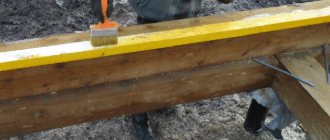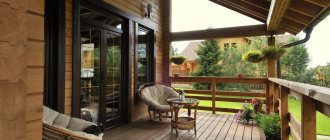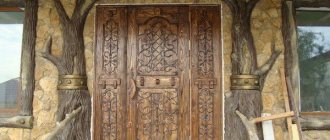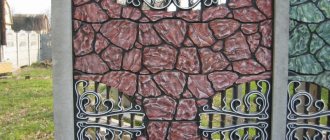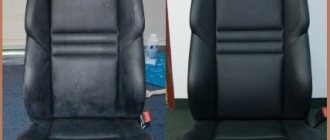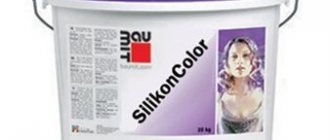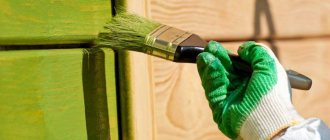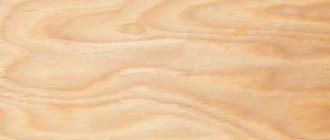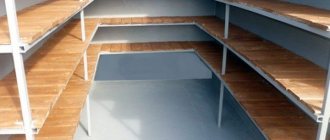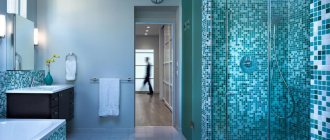And the time comes when you have to renew the coating.
A well-kept gazebo is a decoration for any courtyard of a house outside the city. Unsightly walls, peeling paint, marks from exposure to bad weather - all this, of course, spoils its appearance. In this article, we will look in detail at how and with what to paint a wooden gazebo at the dacha so that it looks presentable and at the same time is reliably protected from rain, snow and wind.
Often, wood is used in the construction of such structures. This material is light in weight and easy to process. It is worth approaching thoroughly and taking into account a number of factors in order to decide how to paint a wooden gazebo. Today, a summer resident has plenty to choose from: there is a large selection of paints suitable for coloring on the market.
How to choose paint based on the condition of the material being processed?
When choosing the composition that is best suited, you need to take into account the current condition of the wood. Namely:
- New wood panel. To paint this material, you should choose a stain; also, any version of varnish and paint would be an ideal solution. Additionally, it is worth treating the coating with a protective compound.
- Board without processing. The best solution here would be colored painting materials. If you paint with stain, the result will be an uneven distribution of the composition, which will spoil the appearance of the building.
- Old wood. In this case, we use exclusively opaque coloring materials.
Wood that has already been painted can also be refinished to give a fresher look or a different color scheme. To do this, you need to know what kind of solution was used and what its composition was. This is important, because when re-dyed, the compositions can interact with each other, which leads to the curling of the coloring material.
If you need to paint a gazebo that was previously painted, then the work is performed in the following sequence:
- remove remnants of old paint using a wire brush or scraper;
- Use a spatula to remove rotten or damaged areas of wood;
- cover the surface with an antiseptic and allow it to dry completely;
- all irregularities are putty, waiting for the putty to dry completely;
- then all treated surfaces are sanded with sandpaper;
- cover the elements with a primer;
- When the primer has dried, paint is applied in two layers.
Separately, it is worth noting that before applying any coating, the material must be treated with antiseptics to protect the wood from the appearance of fungus, mold and pests.
Helpful advice
The appearance of cracks in wooden beams is almost impossible to prevent. Moisture begins to accumulate in them, which will lead to the destruction of the material. To avoid this, you need to:
- Small cracks should be re-treated with protective mixtures, primed and then painted over.
- Large cracks are first coated with impregnating solutions, after which they are filled with putty or plastoelastic non-curing sealant, and the leveled base is painted.
We will talk about how to paint a gazebo in the next article.
If you take timely care of the gazebo, it will delight you with its appearance for a long time, allowing you to relax comfortably on summer days.
Types of materials for painting
What types of painting materials and protective compounds are on the market? Let's take a closer look. There are options that are widely used by gardeners to decorate their gazebos:
- paints and varnishes of dense consistency;
- varnish or oil compositions;
- transparent primers;
- varnish decorative materials.
Each composition has a number of advantages and a number of disadvantages. Therefore, before purchasing, you should have a good understanding of the properties of one or another option.
Thick paint coating
In this case, alkyd compositions specially developed for coating street buildings are used, as well as the vast majority of coloring materials.
How to paint a wooden gazebo:
- Acrylic paint, which contains an acrylic copolymer. The advantage of this material is its environmental safety and increased level of strength. Ideal for high quality wood.
- Silicone mixtures that contain silicon resins. Among the advantages are excellent moisture-proof and vapor-permeable characteristics. After treatment with such compounds, the material acquires a smooth surface, while it has reliable protection from the collection of dust and dirt. The disadvantages include the cost, which is not cheap.
- Silicate compounds, which are characterized by increased water resistance. Liquid potash glass is used as a binder. The paint and varnish material is as waterproof as possible, but it is prohibited to use it on surfaces previously painted with silicone or acrylic paint. Before coating, you must thoroughly clean the surface to be treated.
- Alkyd enamel compositions. Widely used when painting gazebos. Paints based on pentaphthalic or glyphthalic varnishes. It is distinguished from other types by its high strength and resistance to atmospheric influences. Alkyd enamel compositions are diluted with white spirit. It is best to choose paint from a Finnish manufacturer. This is an economical option, and the coating has good durability.
The presence of a huge range of painting materials with a variety of colors will allow you to approach the process creatively and realize any idea for decorating a gazebo.
Transparent primers
There is the following classification:
- Deep processing latex primer. It is breathable and not afraid of getting wet. Ideal for finishing woodwork before painting. Often this composition is used to treat the flooring in a gazebo.
- Primer with acrylic base. This material has antiseptic properties and protects against the appearance of fungus and mold. Used to treat wood before coating.
- Stain. These compositions are made on an alcohol base with a small addition of dye. After application, the material turns out to be a beautiful brown shade. Processing is carried out exclusively on a smooth surface without auxiliary finishing. It is recommended to varnish the wood after covering it with stain.
Primers help increase the strength of wooden structures, while allowing for an even layer of paint to be applied by minimizing the absorption of wood.
Varnish and oil mixtures
The main component of the oil solution is synthetic oil, which will make it much easier to apply paint to wood in the future. The following classification of these compositions is distinguished:
- Drying oil. An ideal solution for preparing wood before coating. After treatment, the surface will become sticky with an increased level of adhesion. Drying oil should be used before painting. If you leave the surface without applying a coloring composition, dust and dirt will soon appear on the material.
- Primers with antiseptic substances. Processing with such material requires a thoroughly cleaned surface beforehand. There is a large catalog of shades when choosing a color scheme. The coating can be matte or glossy; for this, the wood is coated with the composition in several stages.
When using an oil solution, you need to be very careful, since if it gets on your mucous membranes or eyes, it can cause a severe burn. It is advisable to wear protective clothing during work.
Decorative varnish
Processing is carried out only on a smooth surface without roughness or flaws. A primer mixture must be applied in advance.
Colorless varnishes look ideal only on a well-treated, smooth board or on new material.
There are the following types of varnish compositions:
- Toning CV varnishes. Frequent choice of gardeners. After processing, the wood receives a beautiful brown tint. At the same time, it is quite difficult to achieve uniform coverage. The composition is toxic.
- Yacht (parquet) varnish. Excellently protects materials from the influence of sunlight, which is desirable for outdoor buildings. Before application, the wood must be thoroughly cleaned and it must be new.
When choosing what to cover the gazebo with, it is worth considering the characteristics of the coloring compositions and for what conditions they are intended. It is also worth considering the shade parameters so that the wooden structure looks beautiful and organic in the garden or country house. It is not advisable to choose bright colors and you need to consider the level of protection of the selected finish.
Priming a wooden surface before painting
Using a primer before painting is important when the wooden surface is free of old paint.
Modern primers can be divided into water-based and oil-based. The following species can be classified as aquatic:
- Acrylic. This type belongs to the class of deep penetration primers and contains antiseptics that help fight mold and fungi. They allow you to reduce the consumption of paints and varnishes.
- Latex. Able to allow air to pass through, however, they repel moisture. They are an excellent preparatory material for subsequent painting, increase the adhesion force of paint to the surface, and also bind dust particles. Mainly used before painting the gazebo floor.
- Stains. This type of primer is based on an alcohol solution. In most cases it is used as a base coating, however, it requires an additional protective layer, for example, in the form of varnish.
Oil primers include various drying oils. They create excellent conditions for painting. After their application, the surface becomes sticky, creating a reliable protective layer. It is better not to use them as an independent painting material.
Materials for processing floor coverings
We will separately consider the processing of wooden floors in the gazebo. Compositions that provide reliable protection of the entire area and increase its service life are suitable. A good choice would be varnish mixtures or mastic.
The wood of the floor surface is protected with varnish or mastic if you want to preserve the naturalness and natural beauty of the material. These materials are used even on non-valuable wood species, such as poplar, pine, and elm.
There are several types of mastics, the most commonly used are:
- Hot mastic. The composition heats up to 180 degrees Celsius, then cools and hardens. Application is possible only with the participation of professionals, as special equipment is required.
- Water-soluble mastic. Used on hard types of wood. After using this composition, it is not advisable to wash the floor with water.
- Water-based mastic. Widespread. Very easy to apply to any type of wood. Easy care of the treated surface.
- Turpentine mastic. Contains artificial wax and turpentine.
- Mastic with the presence of 100% beeswax. Easy to apply, requires dilution with turpentine. This material is not cheap, as it contains natural substances.
If you use mastic, we note that the composition has a short service life. Floors will need to be resurfaced periodically. You also need to take into account that you will have to rub the surface to remove matte stains and stains.
Varnish products for treating floor coverings are used quite often. They contain softened resin, as well as chemical elements. The properties of synthetics help to maintain the presentable appearance of the floor area for a long time.
Which impregnation is best for wood outdoors - let’s understand the topic
Wood as a material will never lose its relevance. But to maintain its beauty and durability, the surface must be periodically subjected to protective treatment.
In outdoor conditions, impregnation for outdoor use is used for this purpose. Thanks to it, the tree becomes resistant to bad weather, insects, and fire.
The main thing is to choose the impregnation that suits your design and is suitable for its purpose.
What colors to choose for outdoor work
There is a large selection of colors and shades on the market, which can sometimes be difficult to decide on. Then you should use the services of a designer.
Varnish compositions perfectly convey the relief of wood. Transparent paints and varnishes are often used to decorate new panels after sanding, from which the gazebo is built. By tinting, the natural color of the wood becomes saturated, while adding attractiveness and presentability to the appearance of the structure.
Varnish is also an ideal solution for treating the flooring in a gazebo.
When choosing a particular paint color, you should pay attention to its psychological characteristics and use when creating a composition. If you paint the gazebo completely in a dark color, it will look gloomy.
Designers recommend playing with contrasting colors: adding light colors, for example, let the frame be painted dark and the roof light. A light-colored gazebo looks both fresh and attractive. Recreation buildings in beige, yellow, and light wood shades look harmonious. Such flowers play beautifully under the sun's rays.
Shades that are most often chosen for painting gazebos:
- White is used if you want to expand the space. The shade promotes a feeling of purity and renewal. Ideal for buildings with latticework. The downside: the white color often gets dirty, so this gazebo will need regular maintenance.
- Light yellow colors or ocher do an excellent job of imitating natural warm shades. This option is used, for example, for wood that is not of the best quality, which cannot be coated with a transparent varnish composition.
- Blue and green colors are widely used. With the right choice of shade, the gazebo will harmoniously fit into the overall background of the garden and flower beds.
- Black and dark tones are also popular.
- If the wooden structure is for children, then it makes sense to choose bright colors. Moreover, they are interestingly combined with the shades of the benches, chairs and table inside the gazebo.
Conclusion
The choice of painting method for a wooden gazebo is influenced by many factors, including the fairly high price of protective components. But, no matter what the cost of paint and varnish materials, wood protection cannot be neglected, as this may provoke additional costs associated with repairing the gazebo.
You can find more interesting and useful information by watching the video in this article.
Did you like the article? Subscribe to our Yandex.Zen channel
Preliminary preparation before coating
The finishing is done on a dry surface to prevent cracks from forming in the paint in the future. Wood must also be treated with compounds that strengthen and protect against various factors.
Painting of the gazebo begins when a primer, antiseptic, dye and other necessary materials suitable in terms of characteristics, shades and cost have been purchased. Also for work you will need:
- putty knife;
- brushes of different sizes or roller;
- sandpaper;
- wire brush.
The following materials are used for pre-cladding wood:
- Silicate glue is a product that is often chosen to prevent the appearance of fungus and mold. The product must be diluted to the state of sour cream. Water is used for this purpose. The resulting solution is applied to the surface with a brush.
- Composition with the addition of copper sulfate. Prepare the solution: take 10 grams of the component per 10 liters of water.
- A mixture with the addition of boric acid and table salt. Apply this composition in several layers at intervals of a couple of hours.
- Special chemicals that are sold in construction markets. You must carefully read the instructions on the packaging and follow all directions.
- Antiseptic preparations against insect pests, which can also be purchased at construction stores.
If the preliminary preparatory work is carried out correctly, this will significantly increase the service life of the wooden gazebo and help maintain a neat, beautiful appearance for as long as possible. And if you also successfully choose the shades of the design of the structure, this will allow you to harmoniously fit all the elements of the summer cottage into a single picturesque landscape that will delight the eye for many years.
Painting works
For outdoor work, choose dry and warm weather. Be sure to clean the entire surface of obsolete, peeling layers. If possible, it is necessary to eliminate minor defects and resin showing through. This will allow the paint to adhere securely to the surface.
To protect against insect pests and aggressive environments, use a primer that contains all the necessary components. It is advisable to prime twice for the quality and reliability of the coating.
You can treat the surface with special impregnations that help reduce the risk of fire. During processing, each layer is thoroughly dried.
They paint the ceiling first, then move on to the walls, and only then treat the floor in the gazebo.
First of all, all internal work is carried out, and then external work.
As you can see, in order to make the correct choice of materials for painting a gazebo, you need to take into account many factors that are related to the characteristics of the building itself. The date of construction and what kind of wood was used are of great importance. And also a lot depends on the preferences and financial capabilities of the owners of a personal plot or summer cottage.
You can use the services of a designer who will ideally select the necessary materials, taking into account all the features of the gazebo and the client’s wishes.
How to paint a gazebo?
The first step is to carry out preparatory work - clean the surface, prepare equipment and outline an action plan. The following painting tools and building materials should be on hand:
- roller with removable coat;
— brush for removing dust;
— containers for mixing paints and washing brushes and rollers;
— cleaning solutions;
- sandpaper;
— brushes with natural or synthetic bristles;
- a steel spatula for removing resin from the surface of structural elements of a wooden gazebo, etc.
Next, following the instructions from the manufacturer on the paint packaging, you need to apply the composition to the surface of the gazebo and, after it dries, admire the result.
Why impregnate wood?
The material is popular in construction due to the following advantages:
However, a wooden structure that is constantly located on the street is destroyed over time under the influence of:
To prevent spoilage, an impregnation was developed.
It is needed to extend the service life of the material by forming a protective layer on the surface or penetrating deep into the structure.
The drugs are produced in a narrowly targeted manner, when some resist moisture, others – fungus (antiseptics), others – fire (fire retardants), there are decorative ones and more. Complex action impregnations are also available. They are more expensive, but more effective.
It is recommended to work with the product at a temperature of +10 degrees. It will absorb evenly and dry quickly.
In addition, impregnation can be an excellent base for painting. The paint applies well, giving the wood the desired color.
What you need to know about wood species when choosing impregnation
Depending on the type, trees have different degrees of resistance to biodestruction:
Based on absorbency, rocks are divided into 3 categories:
It is important to note that when choosing raw materials for construction outside, the key factor remains the resistance of the rock to destruction, so you need to choose the most resistant ones.
